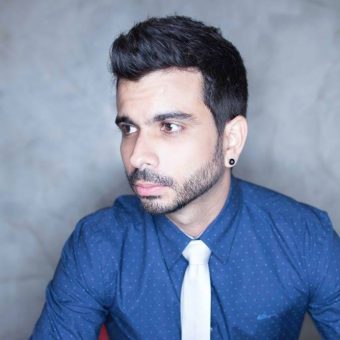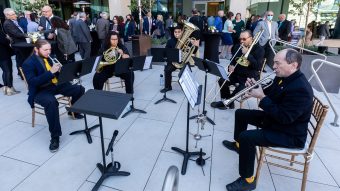Oct. 21, 2021
Contact: Sara Diedrich, 573-882-3243, diedrichs@missouri.edu
When asked to compose a piece of music for the grand opening of the Roy Blunt NextGen Precision Health building, Luis Hermano Bezerra turned to the crown jewel of the 265,000-square-foot facility.
Bezerra, a graduate student at the University of Missouri School of Music, was inspired by Siemens Healthineers’ MAGNETOM Terra-7 Tesla magnetic resonance imaging scanner, or 7T MRI. Not only is the 7T MRI the most powerful MRI scanner in Missouri, but its name contains a number special to musicians.
“Seven is an important number in music,” Bezerra said, adding that there are seven notes in a musical scale. There also are seven scales in Western music — Ionian, Dorian, Phrygian, Lydian, Mixolydian, Aeolian and Locrian. And a seventh interval encompasses seven positions on a musical staff.
“I wanted to compose a piece to express this massive facility in terms of size, but also its importance to the community,” he said. “That’s why I focused on the 7T MRI scanner — which will play an important role as far as research is concerned.”
Bezerra’s piece, “Fanfare for Science,” a two-minute original composition played by Mizzou Brass — a brass quintet made up of three faculty members and two students from the School of Music — made its debut this week during the grand opening of the NextGen facility. The state-of-the-art building will anchor the overall NextGen Precision Health initiative, which is focused on revolutionizing health care, eliminating health care disparities and transforming community health.
Composing excellence through discovery
“Inspiration is a key ingredient to advancing biomedical research and precision health,” said Richard J. Barohn, executive director of NextGen Precision Health and executive vice chancellor for health affairs at MU. “Inspiration and creativity are hallmarks of science and the arts.”
This summer, as plans were being made for the building’s opening, Julia Gaines, director of the MU School of Music and a professor of percussion, suggested having a graduate student compose a piece of music for the event as a way of including the arts in the celebration. The idea was eagerly accepted.
“We have a wonderful composition program,” Gaines said. “Certainly, having a student compose an original piece of music signifies discovery and excellence, which are two of Mizzou’s values. If we don’t engage in commemorations with new works, we will constantly be rehashing the old. At an institute of higher education, creating something new is worth the discovery.”
Additionally, Barohn and his team contacted MU’s School of Visual Studies and the UMKC Conservatory to explore how NextGen could encourage a partnership. The outreach led to identifying more than 20 faculty, artists, musicians and staff committed to creating ways to have bidirectional conversations about precision health.
“I am excited to share that this has led to three collaborations, and we expect many more,” Barohn said.
Along with Bezerra’s composition, the UMKC Conservatory choreographed and performed a dance — inspired by NextGen — that was performed for the building’s grand opening. Additionally, the inaugural art installations for the NextGen building were made by faculty member Katina Bitsicas.
Marching to the beat of his own drum

Bezerra and his brother grew up in Brazil where their father, an engineer, spent most of his career teaching, and their mother was a teacher. He enrolled in college at 17 and received a degree in marketing. But by the time he graduated, Bezerra had already set his sights on another career: music. Eventually, he returned to college to pursue an undergraduate degree in that field.
“When I first went to college, I was young and didn’t really know what I wanted to do,” Bezerra said. “It took me a bit to discover music was my calling.”
As a boy, Bezerra would sneak into his older brother’s room and play his acoustic guitar. But it was the low, deep sound of the bass that snagged his teenage heart, and, before long, he was playing the bass and touring with musicians of many styles across northeast Brazil. Later, while studying music as an undergraduate, Bezerra took a break from his studies and played pop music on a cruise ship, traveling to 36 countries in three years.
It was through these diverse experiences that Bezerra developed an interest in composing and arranging music.
“I am not a classical musician or a popular musician — I am simply a musician,” Bezerra said. “I tend to come up with very different music because my influences are so varied.”
He started arranging popular music for more classical instruments and now enjoys composing pieces that borrow from both classical and contemporary backgrounds.
Composing a fanfare
When he was first approached about composing a piece of music for the NextGen building’s grand opening, Bezerra wondered how he’d find inspiration in a building. He had already composed three pieces of music while at Mizzou, including “Dance Brasileira No. 1,” which was recorded by members of the St. Louis Symphony Orchestra.
“Writing a piece for this facility was challenging at first because I needed to find a purpose to connect what I had to say in my music with the actual building,” Bezerra said.
He quickly realized that fodder for creativity was in NextGen’s mission to bring technology, science and innovation to the world. From there, he discovered the 7T MRI, and his music began to take shape.
Bezerra said that both “seven” and “T” are musical terms in Western music that stand for the measurement between two notes. The notes played at the beginning of “Fanfare for Science” are built on those intervals and are developed over the course of the piece.
“Also, the pace of scientific progress is accelerating. Computers, scanners and revolutionary treatments are the results of the efforts of brilliant minds aiming for evolution,” Bezerra said about his composition. “I translated this notion into fast rhythmic figures toward the end of this work as they symbolize the quick and constant progress that permeates our lives through science.”
Bezerra used the piano to compose the music and then arranged it for the brass quintet that played the piece. From there, he worked with the musicians to make sure what he composed created the sound he imagined once played on all the instruments. It took him about 2 ½ months to complete the piece.
“Collaboration with the performers is very important to the composer,” Bezerra said. “I don’t play brass instruments, so I needed feedback from them so I could adjust my work.”
The beat goes on
It seemed fitting that Bezerra’s eclectic piece of music would help usher in the opening of a facility poised to give researchers unprecedented opportunities to collaborate and make new discoveries. Bezerra said composing “Fanfare for Science” allowed him to collaborate with people outside of music to push his creative boundaries and write a piece that reflects the NextGen initiative.
“I believe composers are nurtured by new connections,” he said.
Eventually, Bezerra plans to pursue a doctorate in music and continue teaching. But for now, he is cherishing opportunities like composing “Fanfare for Science” as he lives his best musical life.
“I would say that I am already working on my dream compositions,” he said. “Being at Mizzou and having the opportunity to do the music I love by mixing my Brazilian heritage with all the new elements incorporated from the relationship with my teachers and colleagues is already a dream come true to me.”
